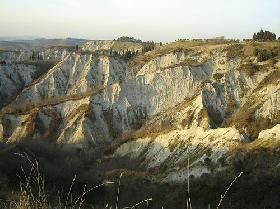If you close your eyes and imagine a Tuscan landscape, what immediately comes to mind are the lush rolling hills, perhaps dotted with proud cypress trees all in a row, an explosion of yellow sunflowers in the fields and majestic farmhouses that rule the countryside.
The southeast area of Tuscany is decidedly out of the ordinary. Winding roads, clay deserts, badlands and “biancane” land formations make for a landscape that is often described as lunar or desert-like.
We are taking paths that cross the famous Crete Senesi, known in the Middle Ages as “Accona Desert”. Precisely during this time period, thanks to its clay properties, it was the subject of many great artistic works including Ambrogio Lorenzetti’s fresco “The Allegory of Good and Bad Government”

The Crete Senesi territory in the province of Siena includes the municipalities of Asciano, Buonconvento, Monteroni d’Arbia, Rapolano Terme, San Giovanni d’Asso and Trequanda. The name derives from the main properties of this land, clay, or in Tuscan dialect, CRETA. A mixture of salt crystals and gypsum, clay represents the sediment of the Tyrrhenian Sea, which covered the area during the Pliocene epoch (2.5-3.5 million year ago). As evidence of this, there are the paleontological finds uncovered just a few kilometers from San Giovanni d’Asso. We are talking about the remains of “Brunella”, the name given to the almost 10m whale fossil near Montalcino. It is one of the biggest and oldest whale fossils ever found in Italy and in the Mediterranean area.
Brunella was resting in a vineyard of Montalcino: the complete skeleton of this over 5million year old cetacean was found among the rows of the famous Brunello wine in 2007. Thus we are talking about a special land, which holds precious treasures and favours the production of grapes and gives complexity and fragrance to the wines made here
 As a result of the human hand which endeavoured to make the land fit for cultivation, the distinctive badlands, or gullies caused by erosion, and the “biancane” or small domeshaped formations, both typical of clay-like terrain, are increasingly less common. Areas which maintained original characteristics are the “biancane di Leonina”, the badlands of Monte Oliveto.
As a result of the human hand which endeavoured to make the land fit for cultivation, the distinctive badlands, or gullies caused by erosion, and the “biancane” or small domeshaped formations, both typical of clay-like terrain, are increasingly less common. Areas which maintained original characteristics are the “biancane di Leonina”, the badlands of Monte Oliveto.
 All around this magical territory are medieval hamlets, parish churches, castles but mostly old farmhouses, evidence of the importance of farming. In fact, this area was known as the “granary of Siena”. The harsh morphological nature of the terrain only allows for the cultivation of grains, sunflowers and fodder. At the end of the 1960s, the countryside was abandoned only to see the immigration of shepherds, mostly from Sardinia, who brought pecorino sheep cheese to the area. It is not uncommon to find herds of sheep at sunset, making the view even more picturesque.
All around this magical territory are medieval hamlets, parish churches, castles but mostly old farmhouses, evidence of the importance of farming. In fact, this area was known as the “granary of Siena”. The harsh morphological nature of the terrain only allows for the cultivation of grains, sunflowers and fodder. At the end of the 1960s, the countryside was abandoned only to see the immigration of shepherds, mostly from Sardinia, who brought pecorino sheep cheese to the area. It is not uncommon to find herds of sheep at sunset, making the view even more picturesque.
Along the dirt roads that cross the territory, there are many charming places where you can stop. Not to be missed are the Monte Oliveto Maggiore Abbey, the town of Buonconvento, Cave di Travertino in Serre di Rapolano, and the oldest part of the Crete Senesi which is the area around San Giovanni d’Asso where the most precious and expensive white truffles can be found. There is even a white truffle market and fair as well as a museum inside the Castle of San Giovanni d’Asso.
